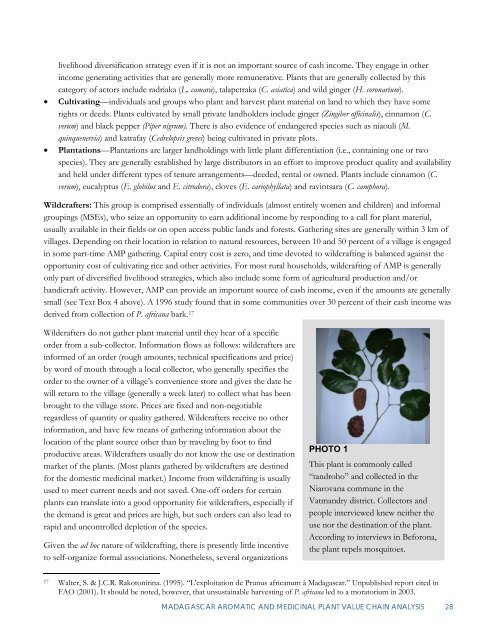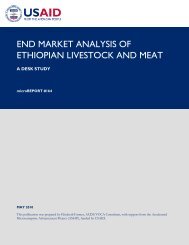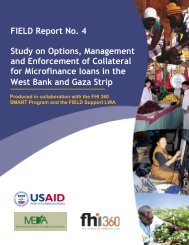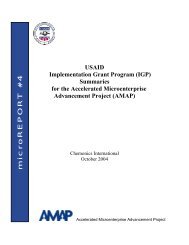Madagascar Aromatic and Medicinal Plants Value - Microlinks
Madagascar Aromatic and Medicinal Plants Value - Microlinks
Madagascar Aromatic and Medicinal Plants Value - Microlinks
Create successful ePaper yourself
Turn your PDF publications into a flip-book with our unique Google optimized e-Paper software.
livelihood diversification strategy even if it is not an important source of cash income. They engage in other<br />
income generating activities that are generally more remunerative. <strong>Plants</strong> that are generally collected by this<br />
category of actors include radriaka (L. camara), talapetraka (C. asiatica) <strong>and</strong> wild ginger (H. coronarium).<br />
• Cultivating—individuals <strong>and</strong> groups who plant <strong>and</strong> harvest plant material on l<strong>and</strong> to which they have some<br />
rights or deeds. <strong>Plants</strong> cultivated by small private l<strong>and</strong>holders include ginger (Zingiber officinalis), cinnamon (C.<br />
verum) <strong>and</strong> black pepper (Piper nigrum). There is also evidence of endangered species such as niaouli (M.<br />
quinquenervia) <strong>and</strong> katrafay (Cedrelopsis grevei) being cultivated in private plots.<br />
• Plantations—Plantations are larger l<strong>and</strong>holdings with little plant differentiation (i.e., containing one or two<br />
species). They are generally established by large distributors in an effort to improve product quality <strong>and</strong> availability<br />
<strong>and</strong> held under different types of tenure arrangements—deeded, rental or owned. <strong>Plants</strong> include cinnamon (C.<br />
verum), eucalyptus (E. globilus <strong>and</strong> E. citrodora), cloves (E. cariophyllata) <strong>and</strong> ravintsara (C. camphora).<br />
Wildcrafters: This group is comprised essentially of individuals (almost entirely women <strong>and</strong> children) <strong>and</strong> informal<br />
groupings (MSEs), who seize an opportunity to earn additional income by responding to a call for plant material,<br />
usually available in their fields or on open access public l<strong>and</strong>s <strong>and</strong> forests. Gathering sites are generally within 3 km of<br />
villages. Depending on their location in relation to natural resources, between 10 <strong>and</strong> 50 percent of a village is engaged<br />
in some part-time AMP gathering. Capital entry cost is zero, <strong>and</strong> time devoted to wildcrafting is balanced against the<br />
opportunity cost of cultivating rice <strong>and</strong> other activities. For most rural households, wildcrafting of AMP is generally<br />
only part of diversified livelihood strategies, which also include some form of agricultural production <strong>and</strong>/or<br />
h<strong>and</strong>icraft activity. However, AMP can provide an important source of cash income, even if the amounts are generally<br />
small (see Text Box 4 above). A 1996 study found that in some communities over 30 percent of their cash income was<br />
derived from collection of P. africana bark. 17<br />
Wildcrafters do not gather plant material until they hear of a specific<br />
order from a sub-collector. Information flows as follows: wildcrafters are<br />
informed of an order (rough amounts, technical specifications <strong>and</strong> price)<br />
by word of mouth through a local collector, who generally specifies the<br />
order to the owner of a village’s convenience store <strong>and</strong> gives the date he<br />
will return to the village (generally a week later) to collect what has been<br />
brought to the village store. Prices are fixed <strong>and</strong> non-negotiable<br />
regardless of quantity or quality gathered. Wildcrafters receive no other<br />
information, <strong>and</strong> have few means of gathering information about the<br />
location of the plant source other than by traveling by foot to find<br />
productive areas. Wildcrafters usually do not know the use or destination<br />
market of the plants. (Most plants gathered by wildcrafters are destined<br />
for the domestic medicinal market.) Income from wildcrafting is usually<br />
used to meet current needs <strong>and</strong> not saved. One-off orders for certain<br />
plants can translate into a good opportunity for wildcrafters, especially if<br />
the dem<strong>and</strong> is great <strong>and</strong> prices are high, but such orders can also lead to<br />
rapid <strong>and</strong> uncontrolled depletion of the species.<br />
Given the ad hoc nature of wildcrafting, there is presently little incentive<br />
to self-organize formal associations. Nonetheless, several organizations<br />
PHOTO 1<br />
This plant is commonly called<br />
“t<strong>and</strong>roho” <strong>and</strong> collected in the<br />
Niarovana commune in the<br />
Vatm<strong>and</strong>ry district. Collectors <strong>and</strong><br />
people interviewed knew neither the<br />
use nor the destination of the plant.<br />
According to interviews in Beforona,<br />
the plant repels mosquitoes.<br />
17 Walter, S. & J.C.R. Rakotonirina. (1995). “L'exploitation de Prunus africanum à <strong>Madagascar</strong>.” Unpublished report cited in<br />
FAO (2001). It should be noted, however, that unsustainable harvesting of P. africana led to a moratorium in 2003.<br />
MADAGASCAR AROMATIC AND MEDICINAL PLANT VALUE CHAIN ANALYSIS 28





